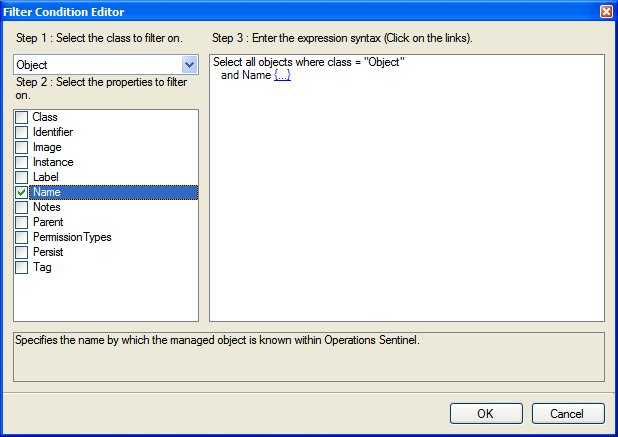The following example specifies a filter condition that does not include any managed object whose name starts with SPO followed by a period (.).
To specify this filter condition
In the display pane for External Applications, select the launch definition you wish to edit.
In the details pane, select the Object Filter property and click the ellipsis (
 ) on the right.
) on the right.The Object Filter Editor appears.
Click the New button to create a new filter condition.
The Filter Condition Editor appears.
In Step 1, select Object. This filters on all managed objects currently defined on the Operations Sentinel server.
In Step 2, select the Name check box. The property is added to the box in Step 3.
The Filter Condition Editor should look like the following:

In Step 3, click the link next to the Name property (
 ) to add the rules for filtering
on the Name property.
) to add the rules for filtering
on the Name property.The Property Filter Editor appears.
In the Property Filter Editor, complete the following steps to exclude all managed objects whose name starts with capitalized SPO followed by a dot (.) from this filter condition:
The first item you see in the Property Filter Editor is the name of the property. Next to the name of the property is a drop-down box that allows you to specify the operator you want to create a rule for. Select the does-not-equal operator (<>).
Next to the operator drop-down box is a fill-in field. This field allows you to enter a regular expression or plain text. Enter the regular expression ^SPO\.
Select the use Case Sensitive comparison check box.
Select the use Regular Expression check box.
The Property Filter Editor should look like the following:

Click OK to close the Property Filter Editor.
Click OK to close the Filter Condition Editor.
In the Object Filter Editor, make sure the filter condition you just defined is enabled.
To enable a filter condition, select the check box next to the desired filter condition. A check mark means the filter is enabled.
Close the Object Filter Editor.
You can view the filter conditions you specified in the Object Filter property, which appear in the form of a Boolean expression.
Test the launch definition before you save it. Once it is saved, the external application is available to all users.
Save your changes.